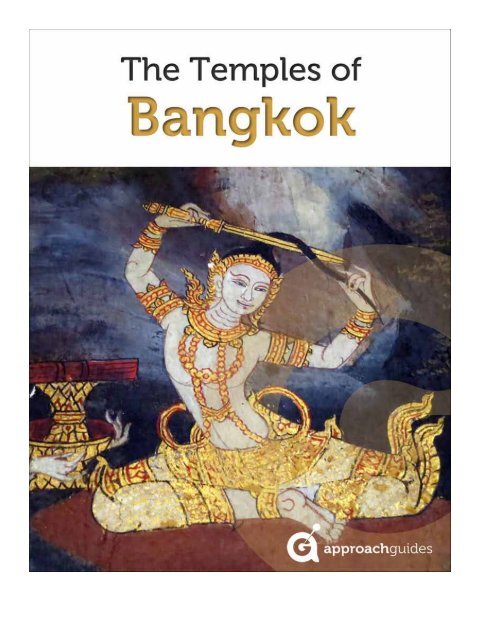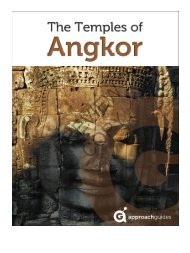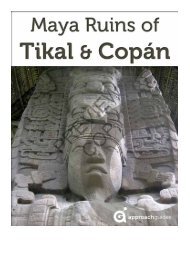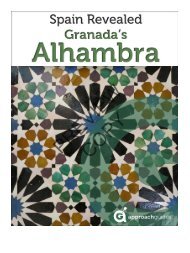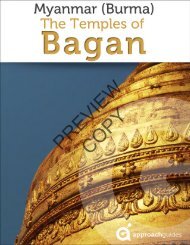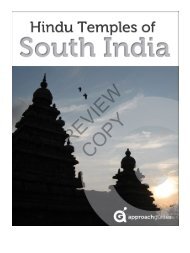The Temples of Bangkok - Approach Guides
The Temples of Bangkok - Approach Guides
The Temples of Bangkok - Approach Guides
Create successful ePaper yourself
Turn your PDF publications into a flip-book with our unique Google optimized e-Paper software.
<strong>The</strong> <strong>Temples</strong> <strong>of</strong> <strong>Bangkok</strong><br />
Version 1.0<br />
by David Raezer and Jennifer Raezer<br />
© 2012 by <strong>Approach</strong> <strong>Guides</strong><br />
(text, images, & illustrations, except those to which specific attribution is given)<br />
All rights reserved. No part <strong>of</strong> this book may be reproduced in any form or by any electronic or mechanical means,<br />
without permission in writing from the publisher. Further, this book is licensed for your personal enjoyment only. This<br />
book may not be resold or given away to other people. If you would like to share this book with another person, please<br />
purchase an additional copy for each recipient.<br />
<strong>Approach</strong> <strong>Guides</strong> and the <strong>Approach</strong> <strong>Guides</strong> logo are the property <strong>of</strong> <strong>Approach</strong> <strong>Guides</strong> LLC. Other marks are the property<br />
<strong>of</strong> their respective owners.<br />
Although every effort was made to ensure that the information was as accurate as possible, we accept no responsibility<br />
for any loss, damage, injury, or inconvenience sustained by anyone using this guidebook.<br />
<strong>Approach</strong> <strong>Guides</strong><br />
New York, NY<br />
www.approachguides.com<br />
ISBN: 978-1-936614-31-8
Introduction<br />
Contents<br />
THE THAI STYLE: ARCHITECTURE, PAINTING, SCULPTURE<br />
Introduction to Thai Temple Architecture<br />
Stupas<br />
Prangs<br />
Vihans and Ubosots<br />
Architectural Decoration<br />
Thai Painting<br />
Subject Matter and Location<br />
Painting Style in Sukhothai Period<br />
Painting Style in Ayutthaya Period<br />
Painting Style in <strong>Bangkok</strong> Period<br />
Thai Sculpture<br />
Buddha Images in Sukhothai Period<br />
Buddha Images in Ayutthaya Period<br />
Buddha Images in <strong>Bangkok</strong> Period<br />
<strong>The</strong> Buddha’s Mudras<br />
DETAILED TEMPLE PROFILES<br />
<strong>Bangkok</strong> (1782-present)<br />
Pr<strong>of</strong>iled Sites in Summary<br />
What To Look For In <strong>Bangkok</strong><br />
Buddhaisawan Chapel *<br />
Wat Arun *<br />
Wat Benchamabophit<br />
Wat Bowornivet<br />
Wat Khrua Wan *
Wat Pho *<br />
Wat Phra Kaeo *<br />
Wat Suthat *<br />
Wat Suwannaram *<br />
Historical Capitals and Major Thai Kings – Chronology<br />
What’s Going On In the Rest <strong>of</strong> the World<br />
Free Updates<br />
More from <strong>Approach</strong> <strong>Guides</strong><br />
Praise for <strong>Approach</strong> <strong>Guides</strong><br />
About <strong>Approach</strong> <strong>Guides</strong>
Previewing this book?<br />
Introduction<br />
Please check out our enhanced preview, which <strong>of</strong>fers a deeper look at this guidebook.<br />
<strong>Bangkok</strong>’s Buddhist temples — spread out like oases throughout the busy metropolis — inspire contemplation<br />
and wonder.<br />
This <strong>Approach</strong> Guide, drawn from our more comprehensive guidebook to the <strong>The</strong><br />
<strong>Temples</strong> <strong>of</strong> Thailand, makes an ideal companion for travelers seeking a deeper understanding <strong>of</strong><br />
Thai art and architecture in <strong>Bangkok</strong>. As context is critical, we focus on differentiating <strong>Bangkok</strong>’s<br />
temples from those <strong>of</strong> the country’s two earlier capital cities, Sukhothai (1238-1368) and Ayutthaya<br />
(1350-1767).<br />
This <strong>Approach</strong> Guide is broken into two sections:<br />
<strong>The</strong> first section, an overview, looks at the primary architectural structures found in a Thai temple<br />
complex — stupa, prang, vihan, and ubosot — and the art forms used to decorate them (paintings<br />
and sculptures). To give a complete picture, we provide floorplans, historical context, images that<br />
highlight specific features and decoration, and descriptions <strong>of</strong> the prevailing Thai aesthetic, including<br />
subject matter and how styles changed over time.<br />
<strong>The</strong> second section <strong>of</strong>fers detailed pr<strong>of</strong>iles <strong>of</strong> nine temples, hand-picked as the best sites for<br />
Thai art and architecture in <strong>Bangkok</strong>. For each site, we discuss the overall layout, the exterior appearance,<br />
and the interior decoration. <strong>The</strong> overall goal <strong>of</strong> these site pr<strong>of</strong>iles is provide travelers<br />
with what is most important, a framework for understanding each site and what makes it<br />
special.<br />
And along the way, this guide provides our personal tips for getting the most from your experience.<br />
This <strong>Approach</strong> Guide contains:<br />
• Nearly 100 high-resolution images — photos and floorplans — with color highlights that<br />
make visual identification <strong>of</strong> key structures easier.<br />
• A quick reference checklist <strong>of</strong> the most distinctive features <strong>of</strong> art and architecture in <strong>Bangkok</strong>.<br />
• A high-level map <strong>Bangkok</strong> to ease navigation and plan your itinerary.<br />
If you are planning on visiting Sukhothai or Ayutthaya, we recommend purchasing our complete<br />
guidebook, <strong>The</strong> <strong>Temples</strong> <strong>of</strong> Thailand, which includes pr<strong>of</strong>iles <strong>of</strong> all three capital cities.<br />
Contact us anytime<br />
Our readers are our greatest inspiration. Email us at founders@approachguides.com to let us know<br />
about your experience with <strong>Approach</strong> <strong>Guides</strong> — many <strong>of</strong> our recent updates have been inspired by<br />
customers like you. We personally respond to every email.
We hope that this cultural guidebook <strong>of</strong>fers you fresh insights into Thailand’s art and architecture<br />
and sets you on a path to making your own discoveries.<br />
Have a great trip!<br />
David and Jennifer Raezer<br />
Founders, <strong>Approach</strong> <strong>Guides</strong>
<strong>The</strong> Thai Stupa<br />
Fig. 4. Thai stupa predecessors and types. Highlights added.<br />
<strong>The</strong>re are three basic forms <strong>of</strong> the Thai Stupa; each will be explored in turn. <strong>The</strong>se forms — as well<br />
as those <strong>of</strong> India, Sri Lanka, and Myanmar’s Bagan (Burma) — are laid out in Fig. 4. Note that<br />
andas are highlighted in green, harmikas in red, chattras in purple, and bases or terraces in black.<br />
We will continue to refer to back to this three style framework as we review the stupas in specific<br />
temples in sections that follow.<br />
Thai stupa type #1: Lotus bud-shaped anda<br />
Where to see it: This chedi is unique to Sukhothai and its satellites cities: Si Satchanalai, Kamphaeng<br />
Phet, and Phitsanulok.<br />
Unlike in later periods where vihans, ubosots, and prangs assumed fundamental importance, stupas<br />
were the central and primary structure in Sukhothai period temples. <strong>The</strong>y are characterized<br />
by their extreme delicacy and spire-like, soaring verticality. See Fig. 5.
Fig. 5. Thai stupa type #1. Wat Mahathat, Sukhothai. Highlights added.<br />
Defining characteristics <strong>of</strong> Thai stupa type #1 include:<br />
• Stepped terraces and redented bases. Two or three square terraces rise to support a<br />
deeply redented (that is, with cutout corners) and tower-shaped base; this base supports the<br />
anda. <strong>The</strong> stepped terraces are a distinctive element <strong>of</strong> the Thai stupa (shared with those <strong>of</strong><br />
Myanmar’s Bagan) and mark a clear push away from earlier Sri Lanka prototypes. Further,<br />
the tower-like bases, which afford these structures their elegance and vertical momentum,<br />
seem to borrow from earlier Khmer prangs (discussed in the next section). See yellow highlights<br />
in Fig. 5.
Defining features<br />
Fig. 14. Thai prang. Highlights added.<br />
As with many architectural forms, the Thai civilization’s chief modification to the Khmer prang was<br />
to make it more delicate, thinner, and vertical in emphasis. That said, the defining features<br />
<strong>of</strong> the Thai prang include:<br />
• More slender, vertical tower (position marked on right side <strong>of</strong> Fig. 14). <strong>The</strong> round Thai<br />
tower is generally thinner than Khmer prototypes and its sides are more nearly vertical all
along its length.<br />
• Vajra (pink highlights in Fig. 14). <strong>The</strong> prang is topped by Indra’s weapon, the thunderbolt<br />
(vajra), symbolic <strong>of</strong> shattering illusion; when illusion is cast aside, the believer is able to<br />
achieve enlightenment and join the Buddha in his mountain residence at the top <strong>of</strong> Mount<br />
Meru. <strong>The</strong> use <strong>of</strong> a vajra is a Thai innovation, as Khmer prangs were topped with ribbed<br />
fruits and pot finials.<br />
• Rising tiers. <strong>The</strong> rising, horizontally tiered terraces <strong>of</strong> the tower are less emphasized than<br />
on Khmer prototypes, in order to stress greater vertical, upward momentum.<br />
• Medial arched niches (red highlights in Fig. 14). <strong>The</strong> cardinal points on each ascending<br />
level <strong>of</strong> the prang have medial arched niches that typically contain images <strong>of</strong> guardian figures<br />
or Buddhas. This is consistent with Khmer precedent.<br />
• Antefixes (blue highlights in Fig. 14). Antefixes sit in the redented (cutout) corners <strong>of</strong> the<br />
tower and serve a dual purpose: (a) they smooth out the redentations, thereby affording the<br />
tower the appearance <strong>of</strong> a more perfectly round plan; and (b) they provide a simple decoration.<br />
<strong>The</strong>se antefixes are generally simpler and less prominent than those <strong>of</strong> Khmer prototypes.<br />
• Internal shrine (green highlights in Fig. 14). A Buddha shrine sits inside, directly underneath<br />
the tower.<br />
• Square, redented base (redentations marked with yellow highlights in Fig. 14). <strong>The</strong> prang<br />
tower sits on a redented, square base, <strong>of</strong>ten consisting <strong>of</strong> several stepped terraces.<br />
• Quincunx arrangement. <strong>The</strong> Khmer’s quincunx arrangement — a central prang surrounded<br />
by four smaller prangs — was used frequently, especially in Ayutthaya.<br />
<strong>The</strong> Thai Prang: Transformation over Time<br />
While the prang is a persistent feature throughout all periods, its appearance changes quite meaningfully<br />
over time, moving progressively away from the earliest Khmer prototype.<br />
Sukhothai period prang<br />
Sukhothai prangs most closely resemble those <strong>of</strong> the Khmer. <strong>The</strong>y sit on modest, simply redented<br />
bases, with prominent antefixes; a Buddha shrine sits under the prang, accessed by a single entrance.<br />
Good examples <strong>of</strong> this style are found at Wats Phra Phai Luang (see Fig. 15) and Si Sawai,<br />
both <strong>of</strong> which are pr<strong>of</strong>iled individually in this guidebook.
Vihans and Ubosots<br />
<strong>The</strong> vihan and ubosot (see Fig. 19) house sacred Buddha images and serve as the principal hall <strong>of</strong><br />
worship for laity and the congregation-ordination hall for monks, respectively. First and foremost,<br />
these buildings were visited to engage in direct and personal interaction with the Buddha.<br />
At the same time, ritual associated with this interaction facilitated education on the fundamental<br />
tenets <strong>of</strong> <strong>The</strong>ravada Buddhism.<br />
Both structures share the same basic architectural pr<strong>of</strong>ile. This section covers their defining architectural<br />
features and points out the unique forms they assume in the Sukhothai, Ayutthaya,<br />
and <strong>Bangkok</strong> periods.<br />
Fig. 19. Ubosot, Wat Na Phra Men, Ayutthaya.
Fig. 21. Distinctive gable decoration: ch<strong>of</strong>a, hang hong, and bai raka. Highlights added.<br />
Garuda (called a ch<strong>of</strong>a) — a mythological bird symbolic <strong>of</strong> the celestial realm — sits at the peak <strong>of</strong><br />
the gabled temple ro<strong>of</strong>s (red highlights in Fig. 21; close-up in Fig. 22).<br />
In Thai cosmology, Garuda serves as Vishnu’s vehicle; Vishnu — one <strong>of</strong> the three main Hindu gods,<br />
responsible for preserving and maintaining the universe — was adopted as a defender <strong>of</strong> <strong>The</strong>ravada<br />
Buddhism in Thailand. In <strong>Bangkok</strong>, in particular, the bird carries a political, as well as religious,<br />
significance: <strong>Bangkok</strong>’s Chakri dynasty, rulers <strong>of</strong> the city since its founding in 1782, claims lineage<br />
from Vishnu. This explains why all Chakri rulers go by the name <strong>of</strong> Rama, the famous hero <strong>of</strong><br />
the Ramayana epic, who is an incarnation <strong>of</strong> Vishnu. Garuda’s presence, therefore, on the peak <strong>of</strong><br />
gabled temple ro<strong>of</strong>s serves as a reminder <strong>of</strong> the dynasty’s link to this powerful god and its shared<br />
role in defending the city.
Yaksha or Dvarapala<br />
Fig. 28. Kinnara and dvarapala. Highlights added.<br />
Yakshas or dvarapalas are demon guardians with snarling faces that greet the faithful at the<br />
entrance to Buddhist temple complexes (red highlights in Fig. 28). <strong>The</strong>ir role is not, as one might<br />
first be inclined to believe, to scare away evil spirits. Rather, their role is to inspire fear in the<br />
faithful. In order enter the temple complex, the believer must face these figures and abandon his<br />
fear, which is derived from his attachment to worldly things and his physical body; in so doing, he<br />
has begun the process toward Buddhist enlightenment.
Thai Painting<br />
<strong>The</strong> murals created to decorate religious complexes are a highlight <strong>of</strong> the Thai artistic tradition. In<br />
an attempt to get to the core <strong>of</strong> what makes these paintings so impressive, this section begins by<br />
laying out the defining characteristics <strong>of</strong> the Thai painting style; it then describes prevailing<br />
subject matter and their typical positions on the walls <strong>of</strong> the temple; and finally, in subsequent<br />
sections, it concludes with a review <strong>of</strong> the distinctive stylistic elements <strong>of</strong> paintings<br />
in the Sukhothai, Ayutthaya, and <strong>Bangkok</strong> periods.<br />
Medium and Technique<br />
Thai frescoes are made with tempera paint, consisting <strong>of</strong> mineral- and plant-derived colors;<br />
rather than using egg as a binder (as in Western technique), the Thai used animal glues or tree gum.<br />
Prior to the 18th century, when paints began to be imported from China in powdered form and the<br />
spectrum <strong>of</strong> colors expanded, they were based on a more limited range <strong>of</strong> natural colors drawn from<br />
riverbed clays, plants, and charcoal soot: red, yellow, green, white, and black.<br />
<strong>The</strong>se paints are applied to a dry wall <strong>of</strong> plaster that has been covered with slaked lime; this<br />
technique is known as secco fresco and contrasts with buon fresco technique in which paint is applied<br />
to wet plaster.<br />
Secco fresco paintings are vulnerable to moisture and humidity; specifically, the crystallization <strong>of</strong><br />
salt on the surface <strong>of</strong> the walls as a result <strong>of</strong> evaporated ground water rising through porous brick<br />
walls has destroyed many <strong>of</strong> Thailand’s oldest frescoes. In fact, no paintings from the Sukhothai<br />
period remain; and those from the Ayutthaya period are very limited.<br />
Thai Painting Aesthetic<br />
While the Thai painting style does change over time (see the period style review in subsequent sections),<br />
there is a general aesthetic to which it adheres:<br />
• Linear painting style with gentle curves. Thai painting employs an elegant, linear style.<br />
Thai paintbrushes contribute to this aesthetic, as their bristles are made from the roots and<br />
bark <strong>of</strong> trees; the hard quality <strong>of</strong> these bristles allows artists to create precise, thin lines<br />
<strong>of</strong> consistent width. Further, lines are <strong>of</strong>ten smooth and gently curve; there are<br />
virtually no straight lines. Designs are first outlined in ochre or black and then filled in with<br />
color; the outlines remain visible in the finished work, giving the lines prominence.<br />
• Small size <strong>of</strong> scenes and figures. <strong>The</strong>re is a striking relative difference between the large<br />
overall size <strong>of</strong> the wall space and the small size <strong>of</strong> the figures in the painted scenes. This<br />
small form factor was likely pursued in order to convey the maximum amount <strong>of</strong> didactic elements<br />
in a single scene.<br />
• Flat, two-dimensional representations. Thai painting is characterized by a general absence<br />
<strong>of</strong> depth and perspective; images employ flat color, with no shading. This changed<br />
in the Late <strong>Bangkok</strong> period, however, beginning with Rama IV, as Western techniques were<br />
introduced.
Buddha Images in Sukhothai Period<br />
Fig. 44. Sukhothai period Buddha.<br />
Sculpture is probably the highest art form <strong>of</strong> the Sukhothai civilization. <strong>The</strong> best works<br />
were completed in the High Classic period in the 14th century, before the sacking <strong>of</strong> the city in 1438<br />
by Ayutthaya.
<strong>Bangkok</strong> (1782-present)
Pr<strong>of</strong>iled Sites in Summary<br />
Author Tip: To make things easier and allow you to focus on the real highlights, particularly<br />
if you only have limited time in this city, we have marked those sites that we believe are mustsees<br />
with asterisks (*) .<br />
Itinerary<br />
• * Buddhaisawan Chapel in the National Museum (Ratanakosin). Notable for: an absolute<br />
highlight and the best example <strong>of</strong> the Early <strong>Bangkok</strong> painting style.<br />
• * Wat Arun (Thonburi). Notable for: the enormous prang assumes its most refined form in<br />
Thailand, thinner and more vertical in orientation.<br />
• Wat Benchamabophit (Dusit). Notable for: marble building material; paintings in Song<br />
Panuat Chapel; 53 Buddha images representing different periods <strong>of</strong> Buddhist art; stained<br />
glass windows.<br />
• Wat Bowornivet (Dusit). Notable for: paintings by Khrua in Khong, representing the last<br />
stage <strong>of</strong> the <strong>Bangkok</strong> style that incorporates Western techniques (perspective) and subject<br />
matter into Thai painting; a Sukhothai seated Buddha statue.<br />
• * Wat Khrua Wan (Thonburi). Notable for: the most complete and best preserved set <strong>of</strong><br />
Jataka paintings in Thailand.<br />
• * Wat Pho aka Chetuphon (Ratanakosin). Notable for: the ubosot has impressive sandstone<br />
Ramayana reliefs and a number <strong>of</strong> impressive Buddha images; four large stupas conforming<br />
to Thai stupa style #3; the vihan has an enormous reclining Buddha.<br />
• * Wat Phra Kaeo (Ratanakosin). <strong>The</strong> most revered and famous monument in <strong>Bangkok</strong>,<br />
imbued with both religious and political significance. Notable for: Phra Si Ratana chedi (built<br />
to emulate those <strong>of</strong> Ayutthaya’s Wat Si Sanphet); a grand ho trai (library); the best example<br />
<strong>of</strong> a prasat in <strong>Bangkok</strong>; Ramayana paintings from the Rama III period; the Emerald Buddha<br />
sculpture.<br />
• * Wat Suthat (Phra Nakhon). Notable for: enormous scale ubosot and vihan; world-class<br />
paintings in the vihan, representing the high point <strong>of</strong> the Thai all-over aesthetic; bronze Sukhothai<br />
Buddha.<br />
• * Wat Suwannaram (Thonburi). Notable for: unrivaled Rama III <strong>Bangkok</strong> style paintings<br />
that signal a stylistic break with the earlier, more traditional style.<br />
Logistics<br />
We suggest using a tuk-tuk or taxi for visiting the temples on the east side <strong>of</strong> the river. And for touring<br />
sites on the west side (Thonburi), we recommend taking the Tha Thien Ferry (near Wat Pho)<br />
across to Wat Arun. After Wat Arun, it is easy to take a tuk-tuk to Wat Khrua Wan and Wat Suwannaram.
Background<br />
Wat Arun *<br />
Located in <strong>Bangkok</strong> (Thonburi neighborhood), Wat Arun (aka Temple <strong>of</strong> the Dawn) was originally<br />
built by King Taksin (ruled 1767-1782) to house the Emerald Buddha; it held this image from<br />
1768 until it was relocated to Wat Phra Kaeo in 1785. <strong>The</strong> temple was expanded to its present size<br />
under Kings Rama II (ruled 1809-1824) and Rama III (ruled 1824-1851).<br />
Author Tip: Commanding a prime spot in Thonburi along the banks <strong>of</strong> the Chao Phraya<br />
river, Wat Arun is the <strong>Bangkok</strong> style prang par excellence.<br />
Fig. 56. Floorplan, Wat Arun. Highlights added.
Layout and Appearance<br />
• Dual vihans (yellow highlights in Fig. 56) afford access from the east. Visitors enter the<br />
complex by walking between them.<br />
• A massive, central prang (red highlights in Fig. 56; also see Fig. 57) sits atop three aggressively<br />
redented, octagonal terraces. <strong>The</strong> prang is topped by Indra’s weapon, the<br />
vajra (thunderbolt); the vajra symbolically shatters illusion, thereby enabling the faithful to<br />
achieve enlightenment.<br />
• Four mandapa pavilions (green highlights in Fig. 56), aligned with the cardinal points,<br />
sit at the base <strong>of</strong> staircases that rise to the upper terrace.<br />
• <strong>The</strong> central prang is surrounded by four smaller, similarly-shaped prangs (also in red<br />
highlights in Fig. 56) on the intra-cardinal directions, forming a Khmer-inspired quincunx<br />
arrangement.<br />
<strong>The</strong> Prang<br />
While its general appearance and quincunx arrangement are tightly grounded in Late Ayutthaya architectural<br />
precedent, Wat Arun’s prang achieves a new level <strong>of</strong> refinement; it is the most<br />
distinctively Thai manifestation <strong>of</strong> this architectural form (see Fig. 57). It has two defining<br />
features that separate it from all prangs that came before it:<br />
• Wat Arun’s tower is markedly thinner than those <strong>of</strong> all prior Ayutthaya prangs, which<br />
tended to assume more bulbous proportions, in line with Khmer prototypes.<br />
• It also has an even more pronounced vertical orientation, as the square terraces on<br />
which it sits are taller and even more aggressively redented; in this manifestation, the base<br />
has seamlessly integrated with the prang tower it supports.<br />
To contextualize the magnitude <strong>of</strong> these two changes, see the comparison in Fig. 57 <strong>of</strong> Wat Arun<br />
with the Late Ayutthaya period prang <strong>of</strong> Wat Chai Watthanaram (built 1630) in Ayutthaya.
Fig. 57. Prang comparison: Wat Chai Watthanaram, Ayutthaya (left) and Wat Arun, <strong>Bangkok</strong> (right).<br />
Surface Decoration<br />
All surfaces are decorated with shards <strong>of</strong> broken Chinese pottery that have been donated by the<br />
faithful, in lieu <strong>of</strong> the more typical glass mosaics. This Chinese-derived aesthetic became popular<br />
under Rama III.<br />
Sculpture<br />
<strong>The</strong> review <strong>of</strong> Wat Arun’s extensive sculptural decoration is organized by location.<br />
Bases <strong>of</strong> terraces and central prang<br />
<strong>The</strong> bases <strong>of</strong> the terraces and central prang are supported by encircling lines <strong>of</strong> guardian figures —<br />
yakshas and kinnaras (half human-half bird figures), respectively — that stand shoulder-to-shoulder<br />
and appear to strain under the weight <strong>of</strong> the levels above. See Fig. 58.
Central prang<br />
Fig. 58. Yakshas supporting the terraces, Wat Arun.<br />
Midrise on the central prang are double-arched niches (aligned to the cardinal points) that contain<br />
images <strong>of</strong> the Hindu god Indra, depicted riding his three-headed elephant, Airavata (see<br />
Fig. 59). Indra, as Lord and defender <strong>of</strong> heaven (specifically, Tavatisma heaven in Buddhist belief),<br />
holds a position <strong>of</strong> reverence in <strong>Bangkok</strong>; it is he who bestowed salvation upon the Thai people after<br />
the sacking <strong>of</strong> Ayutthaya, affording the city <strong>of</strong> <strong>Bangkok</strong> the status <strong>of</strong> heaven on earth. Here, from his<br />
position in Tavatisma heaven, he stands as the ultimate guardian <strong>of</strong> the temple’s peak and the Buddha<br />
shrines that reside behind him in the niche; in this role, he is protector <strong>of</strong> enlightenment itself.
Mandapa pavilions<br />
Fig. 59. Indra sculpture on central prang, Wat Arun.<br />
Each <strong>of</strong> the mandapa pavilions houses a sculpture depicting a key event in the life <strong>of</strong> the Buddha:<br />
• North mandapa: <strong>The</strong> Birth <strong>of</strong> the Buddha.<br />
• East mandapa: <strong>The</strong> Buddha, in meditation after having achieved enlightenment, is provided<br />
with cover by a naga (a serpent named Mucalinda) during a fierce rainstorm.
• South mandapa: <strong>The</strong> First Sermon at Sarnath.<br />
• West mandapa: <strong>The</strong> Death <strong>of</strong> the Buddha (mahaparinirvana).<br />
Smaller prangs<br />
On each <strong>of</strong> the four smaller prangs, four double-arched niches (also aligned to the cardinal points),<br />
mirroring those that sit midrise on the central prang, enclose depictions <strong>of</strong> Phra Phi, god <strong>of</strong> the<br />
wind, portrayed atop his winged horse.
Free Updates<br />
We are constantly updating and improving our guidebooks with new content, images, and author<br />
tips. One <strong>of</strong> the benefits <strong>of</strong> being a digital (and independent) publisher is that we are able to release<br />
updated versions <strong>of</strong> our guidebooks to our existing customers for free.<br />
Author Tip: <strong>The</strong> easiest way to make sure you have the latest version is to sign up to get notified<br />
<strong>of</strong> updates by email (no spam, promise!).<br />
How do I find out if I have the latest version <strong>of</strong> this guide?<br />
• Look on the title page <strong>of</strong> your guidebook to find its version number.<br />
• <strong>The</strong>n simply visit http://www.approachguides.com/updates where we list the latest version<br />
numbers for each guidebook.<br />
How do I get the latest version?<br />
• If you discover that you do not have the latest version, getting an updated version is easy.<br />
• Visit http://www.approachguides.com/updates for detailed download instructions.
<strong>The</strong> <strong>Approach</strong> <strong>Guides</strong> Catalog<br />
ITALY<br />
Italian Wine Guide<br />
Guide to the Regional Foods <strong>of</strong> Italy<br />
<strong>The</strong> Architecture <strong>of</strong> Venice<br />
More from <strong>Approach</strong> <strong>Guides</strong><br />
Also available:<br />
<strong>Approach</strong> <strong>Guides</strong> Wine App for iPhone and iPad<br />
(http://agwine.com)<br />
Ancient Mosaics <strong>of</strong> the Mediterranean (including Milan, Naples, Sicily and Venice/Ravenna)<br />
Last Supper Frescoes <strong>of</strong> Florence<br />
<strong>The</strong> Romanesque Churches <strong>of</strong> Puglia (Apulia)<br />
INDIA<br />
Ajanta & Ellora: Guide to the Ancient Buddhist Caves <strong>of</strong> India
South India: <strong>The</strong> Hindu <strong>Temples</strong> <strong>of</strong> South India<br />
Khajuraho: Guide to the <strong>Temples</strong> <strong>of</strong> Khajuraho<br />
Mughal Architecture <strong>of</strong> Delhi, Agra, and the Taj Mahal<br />
SOUTHEAST ASIA<br />
Cambodia: <strong>The</strong> <strong>Temples</strong> <strong>of</strong> Angkor<br />
Java: <strong>The</strong> <strong>Temples</strong> <strong>of</strong> Java<br />
Myanmar (Burma): Guide to the <strong>Temples</strong> <strong>of</strong> Bagan<br />
Thailand: <strong>The</strong> Art & Architecture <strong>of</strong> Thailand<br />
MIDDLE EAST<br />
Egypt: Islamic Cairo<br />
Jerusalem Architecture: Church <strong>of</strong> the Holy Sepulchre, Dome <strong>of</strong> the Rock, and Western Wall<br />
Christian Icons <strong>of</strong> St. Catherine’s Monastery<br />
Jordan: <strong>Temples</strong> and Tombs <strong>of</strong> Petra<br />
AMERICAS<br />
Mexico, Guatemala, and Honduras: Maya Art & Architecture<br />
New York City: Cast Iron Architecture in SoHo & TriBeCa<br />
Wine Guide to Argentina and Chile<br />
TURKEY<br />
Istanbul’s Hagia Sophia: <strong>The</strong> Church and its Islamic Architectural Legacy<br />
Ancient Mosaics <strong>of</strong> the Mediterranean (specific to travel to Istanbul)<br />
JAPAN<br />
Guide to Sushi & Sake (includes introduction and map to Tsukiji Market in Tokyo, Japan)
WINE GUIDES<br />
Italian Wine Guide<br />
Spanish Wine Guide<br />
Wine Guide to Argentina and Chile<br />
Wines <strong>of</strong> Australia<br />
Wines <strong>of</strong> New Zealand
Praise for <strong>Approach</strong> <strong>Guides</strong><br />
Compulsive (and compulsively informed) travelers, the Raezers are the masterminds behind<br />
the downloadable <strong>Approach</strong> <strong>Guides</strong>, which are filled with a university course-worth <strong>of</strong> history<br />
and insights for 62 destinations worldwide. Why we love it. <strong>The</strong> Raezers share our desire for<br />
deep, well-researched information on the wonders <strong>of</strong> the world.<br />
Travel + Leisure<br />
What started as one couple’s travel notes aimed at filling in the gaps in guidebooks has become<br />
<strong>Approach</strong><strong>Guides</strong>.com — a menu <strong>of</strong> downloadable travel guides that cover cultural and historical<br />
topics <strong>of</strong> interest to thoughtful travelers. What’s hot: Bite-sized travel guides that specialize<br />
in topics ranging from ... the foods <strong>of</strong> Italy to one that helps you explore the historical and<br />
architectural significance <strong>of</strong> Angkor’s famous temple structures in Cambodia.<br />
Los Angeles Times
About <strong>Approach</strong> <strong>Guides</strong><br />
<strong>Approach</strong> <strong>Guides</strong> <strong>of</strong>fers a complete range <strong>of</strong> cultural travel guidebooks to locations throughout the<br />
world. Find a guide for your next destination at www.approachguides.com<br />
Join the <strong>Approach</strong> <strong>Guides</strong> travel community<br />
Facebook<br />
Twitter<br />
Contact us anytime<br />
<strong>The</strong> greatest people we meet are the ones who find us through our guidebooks. Email us at founders@approachguides.com<br />
to let us know about your experience with <strong>Approach</strong> <strong>Guides</strong> – – many <strong>of</strong><br />
our recent updates have been inspired by customers like you. We personally respond to every email.<br />
Check out our wine guide for the iPhone, iPod Touch, and iPad at www.agwine.com


